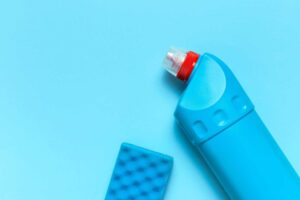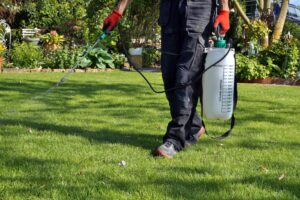Fleas can make life unbearable, both to you and your pet. They can even spread disease and pose a health hazard. These creatures are extremely annoying pests, plain and simple. For instance, a new group of fleas may hatch just when you believe you’ve eliminated the last one in your house. This can result in a new flea infestation, prompting treatment.
However, eliminating fleas isn’t that straightforward; it involves more than just eradicating fleas but also their eggs. And you can use several treatments out there, such as bleach.
There’s been a debate concerning bleach as a solution to eradicating fleas and their eggs for good. Some say it doesn’t, while others believe it does. Some people even claim that they’re unsure if it works at all. So, what really is the truth? Can bleach kill fleas?
In this guide, we’ll answer this question and offer advice on what to do next. So let’s have a peek, shall we?
Short Answer
Yes, it certainly does! Bleach can kill fleas once it gets in touch with them. The chemical’s acidic and poisonous nature decomposes the biological tissues formed by fleas.
The thing is, bleach contains sodium hypochlorite, which in high proportions is acidic. So when it dissolves in water, hypochlorous acid is formed. This acid can permeate the insects’ cell membranes and destroy them. In addition, the gas bleach emits has the potential to kill fleas.
How to Kill Fleas Using Bleach
Since bleach can be a destructive chemical to use, especially in the places we live, you’ll have to be cautious in its preparation and application if you decide to use it to kill fleas.
So, here are some procedures that’ll guide you in administering bleach in your home.
Make a Bleach Solution
You’ll have to measure how much bleach you mix with the water. You can go with a ratio of 10 to 1. This implies that for every 10 ounces of water you use, mix 1 ounce of bleach.
This ratio is important in reducing the likelihood of any health hazards while administering the bleach solution; it’s like a safe zone for you. Now, it’s time to transfer the mix into a spray container to begin work.
Take Safety Precautions
This step is a no-brainer. You’ll need to take the necessary precautions before applying the bleach in your home. For instance, you should always wear safety equipment like protective eyewear and rubber gloves. This helps you avoid physical contact with the bleach. Some examples of protective clothing include long-sleeved shirts, socks, closed-toed shoes, and pants.
You also have to avoid consuming food or drinks when administering bleach. Even after spraying the solution, you have to avoid eating immediately. What you should do is wash your hands thoroughly with soap and water.
Our goal is to kill fleas in your home and not damage your respiratory system. With this in mind, make sure the rooms are well-ventilated and airy.
Using the Bleach
The most effective way to apply the bleach is by using a spray bottle. After filling up the container with some diluted bleach, spray the flooring in your home with it. You’ll have to take it nice and slow for maximum effect. You’ll only miss certain spots if you run through the process, and these places might have flea eggs that could start a new infestation.
Wash and Dry
Allow the solution to sit in the treated areas for a few hours. Then, wash the areas thoroughly and dry them. It’s important to keep yourself, your children, and your pets away from the bleach-treated areas for a while. You can also repeat the whole process to ensure effective treatment.
How Fast Does Bleach Kill Fleas?![]()
Bleach can get rid of fleas in a matter of seconds. However, there are no hard and fast rules here. The concentration of bleach in use will determine how fast it kills the fleas. That’s to say, the more concentrated the bleach is, the faster the fleas die.
Of course, the problem with higher bleach concentration levels is that you’re more likely to be harmed, and because powerful bleach is more acidic, it can damage some household items.
Another driving factor in the effect time is the material on which the bleach was used. For example, a bleach mix may take many hours to permeate into hard polished wood. However, it may take a couple of minutes to begin working on a smooth tiled surface. This is because a smooth surface allows the mix to spread and clean more quickly.
Precautions in the Use of Bleach
If you use bleach as a remedy for flea infestations, there are certain precautions you’ll need to take. We’ll look at a few right away.
Avoid Using Bleach on Your Pet
Bleach is powerful enough to kill fleas on your pet, but it’ll also hurt it in the process. For this reason, it’s strongly advised not to use bleach on your pet.
There’s also the case of accidental ingestion. For example, pets are constantly licking their fur and paws, making them highly likely to ingest the bleach you use.
When this happens, it can pose a lot of health issues. Of course, the severity of the effects depends on the type and amount of bleach ingested, but why risk it? After all, fleas don’t stay on your pet indefinitely. Instead, they drop and hide in the crevices of your home.
So, instead of using this strong solution on your pet, you can use it on objects like your floorboards and other surfaces.
Keep Children and Pets Away From the Treated Areas
Bleach is just as harmful to children as it is to pets. In addition, it can wreak havoc on a child’s respiratory system. So, as we previously mentioned, you should keep your kids and pets away from the areas you’ve sprayed.
If a child accidentally (or even knowingly) ingests bleach, quickly see a physician. And if your pet ingests the bleach as well, you should see a vet before things get out of hand.
When to See the Vet
When your pet ingests concentrated bleach, chemical burns and lesions begin to hit the body. Rush to the vet when this happens, or else you’ll have to watch your pet slowly deteriorate.
In cases where the bleach ingested is a regular diluted bleach, the symptoms may not show immediately. However, you’ll notice some symptoms after some time. These include heavy drooling, soreness, and itching. You might also observe your pet licking its lips incessantly.
All in all, if your pet has been exposed to bleach, seek immediate veterinary treatment rather than attempting to force vomiting yourself. Also, remember to be cool and move your pet to a more secure location if you observe any convulsions or tremors.
Alternatives to Using Bleach to Kill Fleas
Bleach isn’t only detrimental to your family and pets, but it can also harm furniture, rugs, and carpets. While bleach helps eradicate fleas, there are many safer alternatives.
You can use the following household products or remedies:
- Steam Vacuuming or Steam Cleaning: This destroys fleas at all phases of their life cycle and is suitable to use around pets and kids.
- Baby Powder suffocates adult fleas and is quite safe around kids and pets.
- Salt: Adult fleas are killed by salt. While pets and children should be kept out of the treatment area, there are no emissions to fear.
- Coconut Oil or Essential Oils: You can use coconut oil and essential oils (which can be blended with coconut oil and applied topically to boost its potency).
- Epsom Salts: Epsom salts baths can be used to eliminate fleas while also soothing your pet’s skin.
- White Vinegar: White vinegar is effective in killing fleas, but you’ll notice that its effects aren’t immediate. If you’re looking for a slow but sure remedy for fleas, you can try it out.
- Diatomaceous Earth: Try to sprinkle diatomaceous earth on flea-infested areas and witness the death of these pesky insects.
If you prefer mercantile products, there are several alternatives you can turn to. You can find these products in any anti-pest shop around you.
Frequently Asked Questions
Does Bleach Kill Flea Eggs?
Bleach can kill the eggs of fleas as well, but since flea eggs are usually hooked on to the skin of their hosts, you’ll have to wait until they drop off. They usually end up in the cracks around your house. You can introduce the bleach when this happens.
Will Bleach Be Effective on Wooden Surfaces?
Yes. Bleach can kill fleas on wooden surfaces. Whether it’s timber or lacquer, bleach will work. The effect will depend largely on how concentrated the bleach is. However, there’s a catch. Wooden surfaces can generate fissures where fleas can snuggle up to evade the bleach treatment. Of course, this only goes to say that your bleach application must be rigorous.
But note that bleach can react wildly when in contact with the wood’s polish. So, if you want to keep that nice finish for your surface, you can use an oxalic acid solution, which is a type of mild detergent created specifically for wood.
Is Chlorine Effective in Killing Fleas?
Because chlorine is a considerably more potent version of bleach, it’ll kill fleas even more effectively than a standard bleach solution. So, since bleach kills fleas, chlorine will most likely kill them as well, albeit more quickly. However, you need to practice caution during its use.
Is Clorox a Flea Killer?
Clorox bleach is just labeled bleach, so it eliminates fleas in the same way that bleach does. The only difference between Clorox bleach and other bleaches is the concentration; Clorox bleach is diluted for domestic use.
Is Bleach Effective in Killing Termites Too?
Termites are another annoying bug that infests homes and can cause significant havoc. Bleach isn’t just excellent against fleas, but termites as well. However, you need to know that it’s certainly not the ideal way to deal with a termite problem.
What Kill Fleas Instantly?
Nitenpyram, known as Capstar, is one of the most common products used to kill fleas on dogs instantly. However, it’s always recommended to contact your vet before giving any medications to your pet.
How Can I Kill Flea Larvae?
You can kill the flea larvae and other stages of the fleas’ life cycle by laundering your pet bedding, towels, blankets, and other washable items in a washing machine at high temperatures. You can also put them in the dryer afterward; this will make sure that these insects are destroyed.
Final Thoughts
Fleas are insects that you really don’t want lurking in your home. They’re rather stubborn and like to invade homes because they’re warm and cozy; fleas tend to seek warm places to lay eggs.
While bleach is effective in killing fleas, it isn’t the healthiest solution. And when it comes to treatments for your pet and house, you should prioritize safety. After all, using bleach is more of a health hazard than a remedy. With many more healthy alternatives, there’s no reason to get rid of fleas using something that could potentially harm you, your family, and your pet.
References
https://pestguide.org/pest-guide/does-bleach-kill-fleas
https://shuttersflash.com/does-bleach-kill-fleas/
https://pubchem.ncbi.nlm.nih.gov/compound/Sodium-hypochlorite
https://www.msdvetmanual.com/toxicology/household-hazards/chlorine-bleaches
https://www.petmd.com/dog/emergency/poisoning-toxicity/bleach-poisoning-pets-what-you-should-know
https://pets.stackexchange.com/questions/17359/does-bleach-kill-flea-eggs



